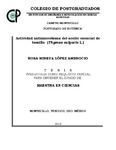| dc.contributor.author | López Ambrocio, Rosa Mireya | |
| dc.contributor.author | LOPEZ AMBROCIO, ROSA MIREYA | |
| dc.creator | LOPEZ AMBROCIO, ROSA MIREYA; 506941 | |
| dc.date.accessioned | 2018-09-20T19:45:06Z | |
| dc.date.available | 2018-09-20T19:45:06Z | |
| dc.date.issued | 2015 | |
| dc.identifier.uri | http://hdl.handle.net/10521/2850 | |
| dc.description | Tesis (Maestría en Ciencias, especialista en Botánica).- Colegio de Postgraduados, 2015. | es_MX |
| dc.description.abstract | Las plantas aromáticas medicinales se caracterizan por poseer propiedades medicinales, olores y sabores específicos, los cuales son el resultado de la presencia de aceites esenciales. La creciente demanda de ingredientes naturales ha impulsado la producción de aceite esencial de alta calidad. El tomillo se comercializa principalmente por sus hojas y por la extracción de su aceite esencial, el cual está compuesto principalmente por monoterpenos (timol, carvacrol y linalol, y-terpineno, p-cimeno, α-Pineno y α-Tujueno). Se conocen diversas propiedades del AE de tomillo, como su actividad antitumoral, antibacteriana, antifúngicas y antioxidantes. En este trabajo se evaluó el efecto que tiene la aplicación de un fitorregulador comercial, la inoculación con rizobacterias promotoras del crecimiento vegetal y hongos micorrízicos arbsculares en el rendimiento, composición y actividad antibacteriana del aceite esencial de tomillo. El mayor rendimiento lo presentó el tratamiento P61 con 13.3 mg AE g-1 MS. Se observó que el número de componentes y el porcentaje presente en el aceite esencial es diferente en cada tratamiento. El tratamiento que presentó mayor concentración de timol fue el Testigo (52.55%), seguido por el tratamiento inoculado con P61 (51.05%) y Zac19+Cedro (50.66%). Para O-Cimeno el tratamiento inoculado con Zac19 (21.79) presenta la mayor concentración, seguido de Zac19+Cedro y Bioforte con 20.38% y 19.37% respectivamente. Respecto a la concentración de J-terpineno Cedro y P61 mostraron mejor respuesta, con 17.91 y 17.84% respectivamente. En la concentración al 50% los tratamientos tuvieron diferencias significativas (Figura 20); el tratamiento con mayor diámetro de inhibición correspondió a las plantas inoculadas con P61. _______________ ANTIMICROBIAL ACTIVITY OF THYME (Thymus vulgaris L.) ESSENTIAL OIL. ABSTRACT: Medicinal herbs are characterized by having medicinal properties, odors, and specific flavors, which they result from the presence of essential oils. The growing demand for natural ingredients has boosted the production of high quality essential oil. Thyme is marketed mainly by its leaves and the extraction of their essential oil, which is composed mainly of monoterpenes (thymol, carvacrol, and linalool, y-terpinene, p-cymene, α-pinene and α-Tujuen). From the essential oil of thyme, various properties are known, as their antitumor, antibacterial, antifungal and antioxidant activity. In this work we evaluated the effect of the enforcement of a commercial plant-growth-regulator, the inoculation with plant growth promoting rhizobacterias and arbuscular mycorrhizal fungi in amount, composition and antibacterial activity of essential oil of thyme. The best performance was achieved by the treatment P61 with 13.3 mg AE g-1 MS. It was observed that the number of components and the percentage present in the essential oil was different for each treatment. The treatment with the highest concentration of thymol was the control (52.55%), followed by the treatment inoculated with P61 (51.05%) and Zac19+Cedar (50.66%). For O-Cymene the treatment inoculated with Zac19 (21.79) had the highest concentration, followed by Zac19+Cedar and Bioforte with 20.38% and 19.37% respectively. Over the concentration of J-Terpinene, Cedar and P61 showed better response, with 17.91 and 17.84% respectively. In the concentration to 50% the treatments had significant differences (figure 20); the treatment with the highest inhibition diameter corresponded to the plants inoculated with P61. | es_MX |
| dc.description.sponsorship | Consejo Nacional de Ciencia y Tecnología (CONACyT). | es_MX |
| dc.format | pdf | es_MX |
| dc.language.iso | spa | es_MX |
| dc.rights.uri | http://creativecommons.org/licenses/by-nc-nd/4.0 | es_MX |
| dc.subject | Tomillo | es_MX |
| dc.subject | Aceite esencial | es_MX |
| dc.subject | Micorriza arbuscular | es_MX |
| dc.subject | Rizobacterias | es_MX |
| dc.subject | Thyme | es_MX |
| dc.subject | Essential oil | es_MX |
| dc.subject | Arbuscular mycorrhizal | es_MX |
| dc.subject | Rhizobacterias | es_MX |
| dc.subject | Botánica | es_MX |
| dc.subject | Maestría | es_MX |
| dc.subject.classification | CIENCIAS AGROPECUARIAS Y BIOTECNOLOGÍA::CIENCIAS AGRARIAS::AGRONOMÍA::BOTÁNICA GENERAL | es_MX |
| dc.title | Actividad antimicrobiana del aceite esencial de tomillo (Thymus vulgaris L) | es_MX |
| dc.type | Tesis | es_MX |
| Tesis.contributor.advisor | Ruíz Posadas, Lucero del Mar | |
| Tesis.contributor.advisor | Delgadillo Martínez, Julián | |
| Tesis.contributor.advisor | García Nava, José Rodolfo | |
| Tesis.date.submitted | 2015 | |
| Tesis.date.accesioned | 2015 | |
| Tesis.date.available | 2015 | |
| Tesis.type | Tesis | es_MX |
| Tesis.format.mimetype | pdf | es_MX |
| Tesis.format.extent | 1,025 KB | es_MX |
| Tesis.subject.nal | Thymus vulgaris | es_MX |
| Tesis.subject.nal | Plantas aromáticas | es_MX |
| Tesis.subject.nal | Essential oil crops | es_MX |
| Tesis.subject.nal | Plantas medicinales | es_MX |
| Tesis.subject.nal | Medicinal plants | es_MX |
| Tesis.subject.nal | Antioxidants | es_MX |
| Tesis.subject.nal | Antioxidantes | es_MX |
| Tesis.subject.nal | Rizobacteria promotora del crecimiento vegetal | es_MX |
| Tesis.subject.nal | Plant growth-promoting rhizobacteria | es_MX |
| Tesis.subject.nal | Nutrición de las plantas | es_MX |
| Tesis.subject.nal | Plant nutrition | es_MX |
| Tesis.subject.nal | Taxonomía vegetal | es_MX |
| Tesis.subject.nal | Plant taxonomy | es_MX |
| Tesis.subject.nal | Escherichia coli | es_MX |
| Tesis.rights | Acceso abierto | es_MX |
| Articulos.subject.classification | Tomillo | es_MX |
| dc.type.conacyt | masterThesis | es_MX |
| dc.identificator | 6||31||3103||241703 | es_MX |
| dc.contributor.director | RUIZ POSADAS, LUCERO DEL MAR; 14244 | |
| dc.audience | generalPublic | es_MX |


